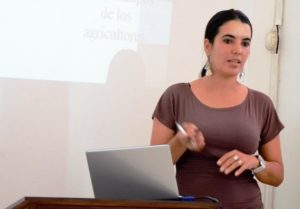
Hanging by the thread of dependence abroad
SANCTI SPÍRITUS –The last inhabitants of Cuba who managed to cultivate the amounts of food they needed to consume were the aborigines. Since then, Cubans have depended to a greater or lesser degree on the importation of edibles to satisfy a demand that has been, not surprisingly, in crescendo.
That’s not my observation; all I did was cultivate some sugar cane and sweet potatoes in the now-extinct countryside schools. It’s the judgment of the experts, who have analyzed every statistic recorded on this island since colonial times. They confirm what we have always known: Cuba has never been self-sufficient, neither in times of plenty nor times of want.
In the era of foreign domination, that fact was irrelevant, subject — as the country was — to macroeconomic policies that overwhelmed it. But the fact that in 58 years of political sovereignty the long-hoped-for alimentary sovereignty has never been attained is certainly worrisome.

“Hanging by a thread” is how Dr. Leidy Casimiro Rodríguez sees our dependence on foreign supply. The agroecology expert has researched the subject not only in books but also and mainly in the daily practices of a broad spectrum of Cuban farmers, in an effort to establish the methodology for the socio-ecological resilience of family farms.
In other words, how the peasants can overcome the influence — almost always negative — of external factors.
“The nation’s economic development depends to a great degree on a greater local production of foodstuff,” the expert maintains. “The importation of food costs Cuba about $2 billion annually, much of it earmarked for the rations that the State distributes to the population and the social consumption in schools, hospitals, daycare centers and homes for the elderly.”
“Every year, we spend higher amounts for the same quantity of food, because of the rising prices on the international market and the cost of transportation, both of which are directly related to the increasing cost of fossil fuels,” she explains. “This systematic growth in imports has a negative effect on the balance of payments due to deficiencies in the domestic supplies.”
Since the late 1980s, the domestic supply of food has not risen as planned. In fact, Cuba’s agro sector has the lowest productivity, because it contributes less than 10 percent of the Gross Domestic Product (GDP) while employing more than 20 percent of the economically active population, according to an article published in 2014 by the Center of Higher Education Studies.
It gets worse. A recent survey shows that 70-to-75 percent of a Cuban family’s budget is earmarked for the purchase of food, a figure that makes one’s wallet tremble.
Cuba has 6.62 million hectares of farm land, representing more than 60 percent of the island’s total area, according to data published in 2015 by the National Office of Statistics and Information (ONEI).
However, the agro sector has been characterized by an agrarian social structure whose predominant productive force is not the peasant farmer but the agricultural worker, single-crop cultivation, a dependence on markets for export, the excessive exploitation of natural resources and the importation of foodstuff, wrote Dr. Leidy Casimiro in her doctoral thesis.
Here’s resounding proof. In the years of so-called “greatest development” in Cuban agriculture (the 1970s and 1980s), there existed a top-notch infrastructure in agricultural machinery and technological packages, irrigation systems, availability and use of 17,000 tons of herbicides and pesticides per year, and 1.3 million tons of chemical fertilizers per year.
Cuba at the time imported 82 percent of the pesticides, 48 percent of the fertilizers and more than 600,000 tons of cattle food concentrates. Even with that injection in the vein of resources to foment agriculture, 57 percent of the foodstuff needed to supply the population was imported. Today, that figure is about 70 percent.
Ever since, there has been a growing dependence on imported food. Negative impacts have been noted in the quality of soil, biodiversity, extensive deforestation, in addition to the high costs of production, low levels of self-sufficiency, the displacement and loss of values and traditions linked to life in the countryside and the production of foodstuff, according to Prof. Fernando Rafael Funes Monzote, who holds a doctor’s degree in Ecological Production and Resource Conservation and a master’s in Agroecology and Sustainable Rural Development.
Especially harmful to food sustainability is the degradation of the soil, a situation that affects more than 75 percent of arable land in Cuba.
Add to this the much-discussed climate change, which has provoked a noticeable increase in temperature, a reduction in rain and, therefore, an exponential increase in the extreme phenomenon called drought.
The Ministry of Science, Technology and the Environment (CITMA) has warned about desertification, which affects 14 percent of the country, and salinization, which has affected approximately 1 million hectares. Those natural ingredients, along with the frequency of hurricanes,make for an unstable scenario in the agro industry.
“We pray as we till,” says Eduardo Martínez, a peasant in Sancti Spíritus who is not familiar with scientific research or probability charts but knows every corner of the farm he started in the late 1980s to guarantee his meals and his cigarettes.
About his dependence on technological packets and the fuel that he never gets in sufficient quantities, he’d rather not talk. Nor does he clearly see the future for food production in Cuba.
“I think we have to look for a formula for the State not to pay for imported food what it can buy from its own farmers,” he says. “How can you benefit a producer in another country and pay for the freight far more than paying a producer right here? That’s not an economy that protects itself.”
Mountainside peasants and renowned agronomers concur: if the State implements a package of measures that attempt to foster alimentary sovereignty, and if it so affirms and reaffirms in a dozen Guidelines — how many quinquennia will it take to abolish dependence once and for all?


